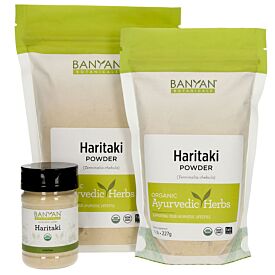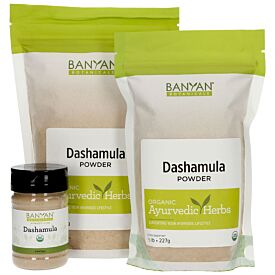Fall Guide
Autumn is dry, rough, windy, erratic, cool, subtle, and clear. These are all qualities shared by vata dosha, and because like increases like, autumn is considered a vata season. This same principle illustrates why taking a few simple steps to balance vata this fall can be tremendously beneficial.
In this Article:
- Fall: The Vata Season
- General Tips for Vata Season
- How to Create a Supportive Fall Diet
- Lifestyle Tips for the Fall Season
- Herbal Support for Fall
Fall is a time of transition. Many trees and shrubs are quietly undressing in preparation for the winter. There is a subtle browning of the earth. Temperatures, which, just a few weeks ago were raging with the intense heat of summer, are beginning to hint at the telltale crispness of autumn.
The fall brings with it a predominance of air element, and prana is abundant in the atmosphere. This season harbors a certain emptiness that can leave us feeling exposed and a little raw, but it is also filled with possibility—a time when we, too, can strip down to a quiet essence of being and savor the simplicity.
Fall: The Vata Season
Ayurveda considers a seasonal routine an important cornerstone of health year-round. Balancing the nature of your local climate with lifestyle choices that offset the potential for seasonally-induced imbalances is one of the simplest ways that you can protect your well-being.
But keep in mind that the seasons vary widely from one place to another, as do the qualities that they engender.
Vata season is whatever time of year most embodies the attributes that characterize vata dosha: dry, light, cold, rough, subtle, mobile, and clear (or empty).
Autumn is the classic vata season. However, depending on where you live, the dry and expansive qualities of vata may be the principal components of your environment in other seasons too—showing as early as summer, and if autumn is followed by a very drying, cold, isolating, or windy winter.
Beginning to observe your environment from this qualitative perspective empowers you to respond to both daily and seasonal changes in your local climate. The truth is that many of us adopt seasonally appropriate habits already—without even being conscious of doing so.
For instance, summer is a time when we often enjoy salads and watermelon in abundance, both perfect antidotes to the heat and intensity of the summer. Whereas by October and November, we’re often baking delicious pumpkin breads and dining on hearty, grounding soups—foods that naturally subdue the dry, light, and erratic nature of the fall.
General Tips for Fall
By making diet and lifestyle choices that counter the effects of each season, you can better maintain your internal sense of equilibrium throughout the year.
If we consider the Ayurvedic principle that opposites balance, vata season will be less aggravating if you fill it with warmth, oiliness, deep nourishment, loving relationships, and a sense of stability, routine, and groundedness.
This article’s following recommendations are appropriate for most people, but for additional considerations specific to your body type or state of balance, select your Ayurvedic body type below.
Vata |
Pitta |
Kapha |
Vata-Pitta & Pitta-Vata |
Pitta-Kapha & Kapha-Pitta |
Vata-Kapha & Kapha-Vata |
Vata-Pitta-Kapha |
||
How to Create a Supportive Fall Diet
Your diet is a powerful way to soothe vata this fall. You may find yourself naturally wanting to increase your intake of food, but be careful to follow the lead of your appetite and digestion.
This is also a great time of year to do a monodiet type of Ayurvedic cleanse. Vata requires adequate nourishment, so it is best to avoid fasting.
Types of Food to Favor in Fall
Substantive, oily, nourishing foods that are high in protein, high in fat, brought to life with warming, stimulating spices, and served hot, will go a long way toward maintaining your internal reserves of moisture and keeping you grounded through the vata season.
- You’ll also want to favor the sweet, sour, and salty tastes. In general, eat mushy, soft foods and garnish them generously with ghee or oil.
- Breakfasts of cooked grains—like oatmeal, tapioca, cream of rice, and cream of wheat—are perfect at this time of year.
- Lunches and dinners that include steamed vegetables, hearty grains, soups, and stews are grounding and moisturizing.
- If you eat meat and eggs, this is one of the best times of year to enjoy them.
- Dairy products and all nuts and seeds are also beneficial.
Ideal Fall Foods
The following is a list of ideal vata season foods:1
Fruits
|
|
Vegetables
|
|
Grains
|
|
Legumes
|
|
Dairy
|
|
Animal Products (If You Eat Them)
|
|
Oils
|
|
Sweeteners
|
|
Spices (Most Are Recommended)
|
|
Foods to Minimize
In general, you’ll want to reduce your consumption of raw vegetables, cold and frozen foods, as well as the bitter, pungent, and astringent tastes.
It is best to minimize light, cooling, and drying foods like broccoli, cabbage, cauliflower, sprouts, leafy greens, white potatoes, beans, popcorn, crackers, millet, and dried fruit.
If you do eat these foods, eat them in moderation and make sure that they are soaked, well cooked, or served with ghee.
Lifestyle Tips for the Fall Season
Practice a daily routine. One of the most effective ways to support vata is by establishing a daily routine. Try to do the same things (wake up, exercise, eat meals, go to bed, etc.) at roughly the same times each day. Set the tone for your day by rising early, taking full advantage of the silence, stillness, and peace that are intrinsic to the early morning hours.
Massage yourself. Then, you can calm your nervous system, awaken your tissues, and ground your energy by massaging your skin with warm, organic Sesame Oil or with an herbal oil. Follow this practice with a warm, relaxing shower, leaving a coat of oil on the skin to absorb throughout the day. Steam baths and humidifiers can help preserve internal moisture as well.
Try yoga and meditation. Some gentle yoga, and 10–15 minutes of meditation will further your sense of stability and wellness.
Use warming aromas. If you enjoy a little fragrance, vetiver, geranium, and citrus essential oils are very appropriate this time of year.
Dress for the season. Wear autumn colors when appropriate—reds, yellows, oranges, and whites—and wear enough clothes that you stay warm throughout the day. When you step out into the elements, cover your head and ears to protect them from the biting wind and cold.
Fall Season Exercise Tips
Vata is very easily aggravated by fast, mobile activities, so consider slow, gentle, strengthening forms of exercise.
- Walking, hiking, swimming, biking, yoga, and tai chi are good choices, provided they are done at an appropriate level of intensity.
- The best times of day to exercise are in the early morning and evening hours (6–10 a.m. and 6–10 p.m.).
- Ideally, exercise at about 50–70 percent of your capacity, breathing through your nose the entire time.
- And remember to balance your activity with adequate relaxation and sleep so that your tissues can rejuvenate properly.
Yoga for Fall
Incorporating a sense of warmth, grounding, stability, and focus into your yoga practice has a profoundly calming effect on vata and can work wonders during vata season. Your breath should be deep and fluid.
If you practice pranayama (yogic breathing exercises), Nadi Shodhana (Alternate Nostril Breathing) is very balancing this time of year.
In your asana practice, favor vata-pacifying yoga. Warm up slowly and include some joint rotations. Move with intention and fluidity—grounding the hands and the feet on the mat whenever possible—and avoid jumping between postures.
- Gentle flows like a relaxed Sun Salutation are perfect for vata. You can also favor standing and balancing poses such as Mountain, Warrior I, Warrior II, and Tree Pose to increase stability and strength.
- Connect with the earth beneath you in poses such as Thunderbolt, Cat-Cow, Cobra, and Child’s Pose, and quiet the mind with forward bends such as Intense Westward Stretch.
- Gentle inversions and restorative poses such as Legs Up the Wall are also very good for vata.
- Close your practice with a long Savasana (Corpse Pose), covering yourself with a blanket so that you don’t get chilled.
Herbal Support for Fall
Ayurveda offers a number of herbs that balance vata that can be especially beneficial during the autumn season. Among them are:
- Chyavanprash. Taking Chyavanprash in the morning can help reinforce immunity, strength, and energy during the autumn season.
- Ashwagandha. Ashwagandha is stabilizing to the mind and nervous system, and can promote sound sleep, strong digestion, proper elimination, and appropriate strength; it is available as a powder, tablet, and liquid extract.
- Herbal Teas. Similarly, herbal teas—especially those made from ginger, licorice, or CCF Tea (a combination of cumin, coriander, and fennel), can promote proper digestion and warmth.
Other grounding, vitalizing herbs and formulas include:
- Dashamula
- Haritaki (also available in tablets)
- Triphala (also available in tablets and as a liquid extract)
- Vidari
- Healthy Vata
- Joint Support
- Mental Clarity
- Stress Ease
- Tranquil Mind
- Vata Digest
Embrace the Season
Remember, a seasonal routine is an investment in your own health and vitality. And while the specifics may vary from one person to the next, we all stand to benefit from aligning ourselves with the rhythms of nature throughout the year. This fall, embrace the unique gifts of autumn and—with the help of an appropriate seasonal routine—enjoy it from a place of stability, humility, and gratitude.











